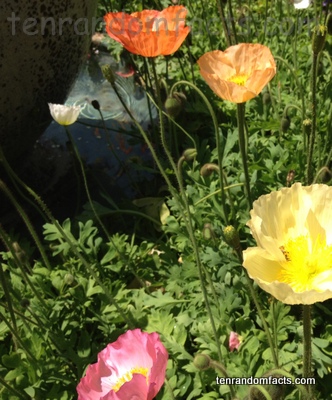Iceland poppies are not found in Iceland.
- Iceland poppies are flowering perennial plants, native to the cool or mountainous habitats in Asia and North America, and are naturalised in Europe.
- The Iceland poppy has the scientific name of Papaver nudicaule, and ‘nudicaule’ literally means ‘naked stem’ in Latin.
- Iceland poppy flowers are white, pink, red, yellow or orange in colour, and are not limited to single colours.
- Iceland poppies grow to be 15 to 45 centimetres (6 to 24 inches) in height and are often grown as annuals or biennials.
- Iceland poppy flowers sit on the end of long hairy stems, with blue-green coloured hairy foliage at the base of the plant.
- Iceland poppies first arrived in London, England in the early 1700s, and it is believed that the first person to successfully grown them in England was Peter Collinson, a cloth merchant and gardener from London.
- Iceland poppy flowers are papery in texture and shaped like a bowl, and can be 8 to 13 cm (3 to 5 inches) in diameter.
- Iceland poppies are easily grown from seed and will usually self seed once established, and they grow best in full sun, but they do not like hot weather and prefer cool summers.
- Iceland poppies are popularly used for decorative purposes in the garden, and are often used as cut flowers.
- Iceland poppies are from the family Papaveraceae, the family of poppies, and bloom from spring to autumn, depending on when they have been planted.
Bibliography:
Iceland Poppy, 2014, Fine Gardening, http://www.finegardening.com/iceland-poppy-papaver-nudicaule
Papaver nudicaule, 2012, Heritage perennials, http://www.perennials.com/plants/papaver-nudicaule.html
Papaver nudicaule, 2014, Wikipedia, http://en.wikipedia.org/wiki/Papaver_nudicaule







